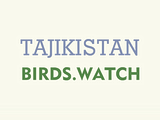search
classification
|
basic information
|
video
|
reports |
Turkestan Shrike
Lanius phoenicuroides (Schalow, 1875)

|
 female
|
|
|
2017-05-26
Kluchevskoi raoin, Altaisky krai |
© Alexei Ebel
|
|
Description
The adult Turkestan Shrike has rusty-brown or grey-brown crown. The forehead is off-white, black mask extended from the bill-base across the eyes to ear coverts. Over the bill the mask presents the narrow black strip separated white forehead from the bill-base. The supercilium is white extended to white forehead before the eyes. Behind the eyes the supercilium is some broader. The mantle and upperwings are grayish-brown, the uppertail and tail feathers are rusty but the central pair of the tail feathers is brownish tinged. The secondaries are brownish with broad buffy edges, the primaries are brownish too but with white bases forming the white speculum. The throat, breast, abdomen and undertail are off-white very slightly pinkish tinged. The flanks are buffy-whitish. The old females have slightly dimmer color; the younger females not only dimmer but also have scaly pattern on the breast and flanks. The ear covets are brownish but not black. The tail feathers are brownish-rusty not clear rusty. The adult males and females have brown eyes and black-brown bill and legs. Juveniles in first plumage have buffy-grey brownish scaly upperparts. The tail feathers are brownish-rusty with brown terminal band separated the pale patches on the ends. The flight feathers are brownish with broad pale edges. The mask is brown. Underparts are off-white with dark scaly pattern. Later in second plumage only a bit of bad visible mottles on the crown and uppertail are kept; on the mantle it are more less. On the wing coverts there is the specific pattern forming by the brown edges separated pale tips of feathers. Sizes: males – wing 87-95, tail 74-87; females – wing 88-94, tail 73-84 mm. Weight: 25.0-41.4 grams.
Distribution
The Turkestan Shrike breeds and occurs on migration in the mountains and plains of the southern half of Kazakhstan. The detailed distribution in Kazakhstan please see in the chapter "Races".
Biology
The Turkestan Shrike is a common breeding migrant. Inhabits riparian, saxaul and deciduous forest, bushy thickets, forest belts, gardens, groves near open areas and plantations, both on plains and in mountains up to 2500-2700 m in Western Tien Shan, where it lives in low juniper bushes with honeysuckle interspersed. During migration reed beds are also visited. Spring migration lasts from mid April to early May. The shrike breeds in separate pairs at 100-300 m one pair from the other. Nest is built in trees (poplar, apple-tree, apricot, saxaul, Russian olive, juniper) or bush (dog-rose, meadow-sweet, honeysuckle, willow, cherry, juniper, barberry) at 0.3 to 7m above curb. It is made from dry grass stems lined with soft grass. Clutches of 4-8, more often of 5-6 eggs are laid late in May to late June. Only female incubates for 15-16 days, while the male feeds her. Both parents feed juveniles, which fledge at 13-14 days in late June to mid August. Single brooded; lost nests are commonly replaced. Autumn migration begins in August, latest birds recorded in early September.
References
"Птицы Казахстана" том 3. "Наука". Алма-Ата, 1970. Gavrilov E. I., Gavrilov A. E. "The Birds of Kazakhstan". Almaty, 2005. Э.И.Гаврилов. "Фауна и распространение птиц Казахстана". Алматы, 1999.








